I normally hope to inspire readers to try new things in the garden, but this before-and-after project comes with a story that I hope will encourage you to start a garden wherever you are in life, with or without home ownership. Whether it's on your windowsill, in the backyard of an ailing family member, for your apartment complex or for a whole community, a garden is a therapeutic gift that brings happiness to yourself and others in inconceivable ways. When my own life gave me manure, I used it to plant this garden at my apartment complex in Jacksonville, Florida.
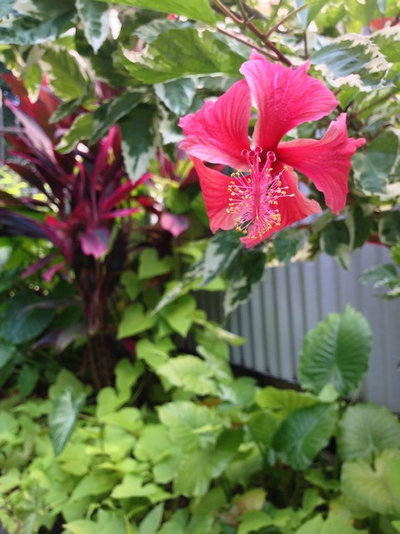 Why I Planted an Apartment Garden
Why I Planted an Apartment GardenI should probably start by telling you how I got the plants and motivation to start this garden in the first place.
Several years ago I planted a garden for my mother, Nancy Asbell, who suffered from an autoimmune disease known as lupus. She received a motorized wheelchair when her spine broke as a result of aggressive steroid treatments, so I hoped to ease the pain by planting a garden that she could see from her porch.
Lupus, with its many complications and treatments, tortured her body relentlessly. In the last year of her life, she struggled to pay medical bills with what she could earn by selling her artwork and teaching piano, and the phone calls from the bank made it clear that she would soon lose the home and garden she loved.
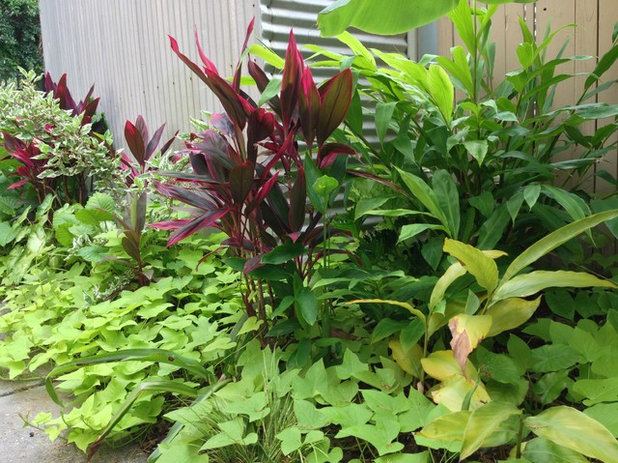
Here's the thing: Despite her hell on earth, my mother was madly in love with all that the world had to offer and celebrated each and every day. She saw illness as a way to better understand and reach out to others as a lupus advocate. She was a resilient and infectiously happy woman who saw miracles in the windswept leaves that most would consider litter, and reveled in the everyday encounters with nature and humanity.
The least I could do in her absence was share her garden so that others (including myself) might find some sort of happiness in their everyday lives.
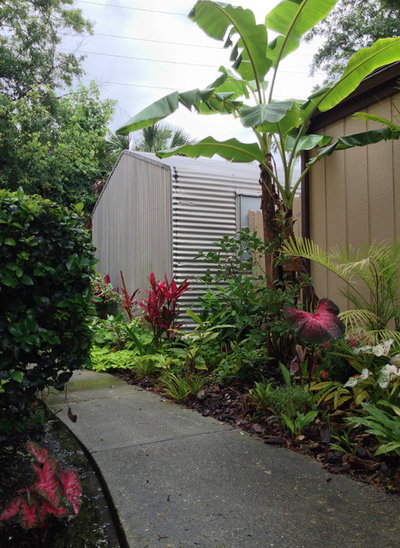
The bank was threatening to foreclose on my mother's house, so I asked my own property manager if I could temporarily replant her garden at my apartment complex until we were able to find my mother another home. She graciously agreed.
When my mother passed away last year, just after her 50th birthday, my only solace was that I could share the world and its miracles with others, one plant at a time. It was ridiculous to assume anybody would care one way or another, but because I was so used to gardening for my mother, the assumption gave me peace.
I justified moving the garden with the hopes that it would benefit my neighbors, but truth be told, digging up plants and ferrying them over the St. John's River gave me a sense of continuity and purpose, which can be so difficult to find following the death of a loved one.
Before Photo
 Building the Garden
Building the GardenI started with the barren patch of grass and mulch outside the apartment complex's laundry room.
Pretty bland, huh? The mulch-covered area was especially tricky, since the arborvitae (
Platycladus orientalis) had choked the soil with a dense network of roots, leaving the entire area under the tree dry as a bone for most of the year.
While I was able to rescue some of the most treasured plants from my mother's garden, I had to purchase others to fill out the space and keep it from looking like a hodgepodge. To make the narrow pathway look bigger and brighter, I chose plants with chartreuse and lime-green leaves.
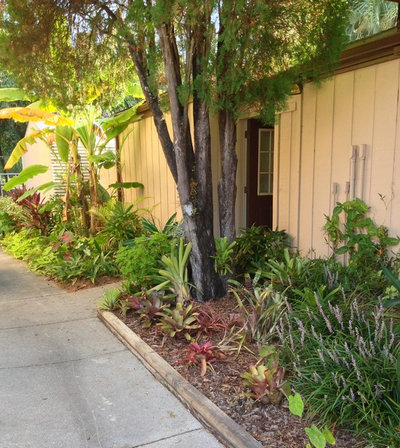 AFTER:
AFTER: My solution for the dry shade under the tree was to plant bromeliads (
Neoregelia,
Aechmea,
Billbergia hybrids, USDA zones 8b to 11), since they take in water through their watertight cups and don't rely on their root systems, as most plants do. In the protected area long the wall, I planted more tender tropical plants, like
reed stem orchid (
Epidendrum radicans, zones 9b to 11), that could also thrive with very little water.
The original
lilyturf (
Liriope 'Evergreen Giant', zones 6 to 11) planting has become established now and provides a soft backdrop for whatever bromeliads I choose to plant in the foreground.
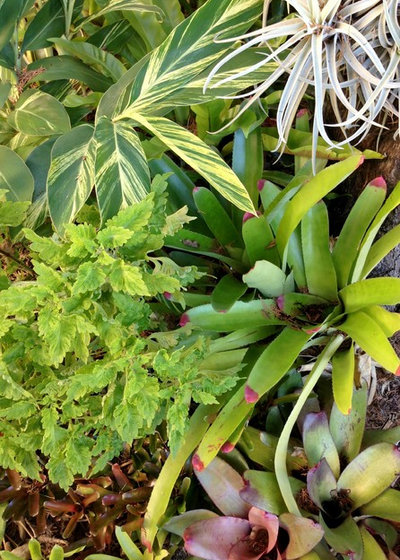
Here you can see a sampling of the plants I used under the tree. Clockwise from the upper-right-hand corner are a
Tillandsia (
Tillandsia spp, zones 10 to 11),
Neoregelia cruenta (zones 9b to 11), a
Neoregelia bromeliad,
fireball bromeliads (
Neoregelia 'Fireball', zones 9b to 11) and a container of
coleus (
Solenostemon hybrid, annual) and
variegated shell ginger (
Alpinia zerumbet '
Variegata', zones 9 to 11). Because the coleus and shell ginger are in a container, I can water them separately without the water's getting absorbed by the greedy roots of the arborvitae tree.
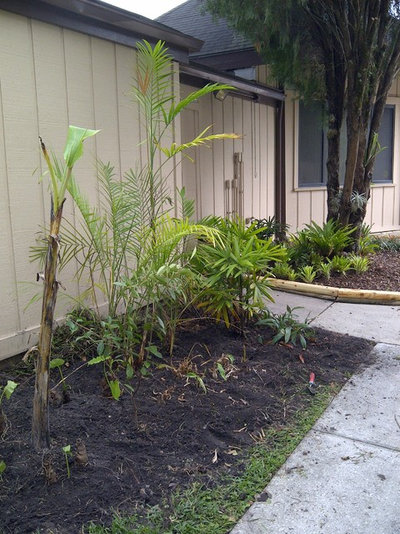
It was hard to believe that these newly planted bulbs and palms would flourish within the year, but hope was all I had to work with during that time. So I started digging and planting, drawing cautious stares from the tenants as I ripped out the grass and tracked dirt all over the sidewalk. I took this photo shortly after adding the first plants; earlier that week you would have seen a sad patch of grass in their place.
The backbone of this planting consists of
ice cream banana (
Musa 'Blue Java', zones 8b to 11),
radicalis palms (
Chamaedorea radicalis, zones 8b to 11) and
lady palm (
Rhapis excelsa, zones 8b to 11).
The apartment complex straddles the line between zones 8b and 9, so I was able to use slightly cold-hardier versions of tropical plants, lending a resort feel to the north Florida poolside. But for the moment, it looked downright ugly.
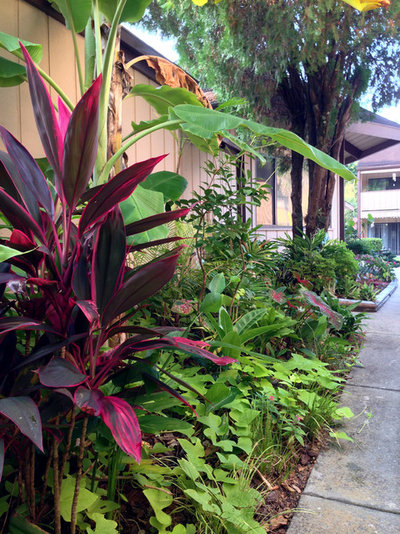
What a difference a year and a half made! The tiny banana plant now towers over the laundry room, with several suckers at its base. The
ti plants (
Cordyline fruticosa 'Red Sister', zones 9 to 11) have grown tall in their protected microclimate, and the
ornamental sweet potato vine (
Ipomoea batatas 'Marguerite', zones 9 to 11, annual elsewhere) has taken it upon itself to cover the garden with a bright green living mulch.
You might be wondering if the ornamental sweet potato vine gets out of control in such a small space. Yeah, it does. I've been pruning the vines once a week to keep them off the sidewalk and will replace them with a less-enthusiastic ground cover next year.
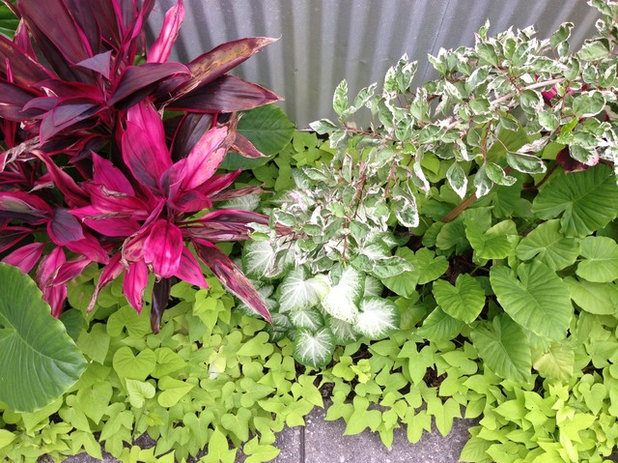 Why Everything Works
Why Everything WorksI am not a professional garden designer, and since I purchased the nonrescued plants on my own dime, the budget was very small. What I think makes this space work is the combination of low-maintenance plants with enough foliage interest to turn heads without the use of flowers. While everyone loves flowers, I used them sparingly so there would be year-round interest — not to mention less work removing the spent blooms.
Continuity was also key, so I repeated certain elements throughout. By sticking to a color scheme of pink, white and lime green, I was able to include a variety of plants without making the garden look cluttered.
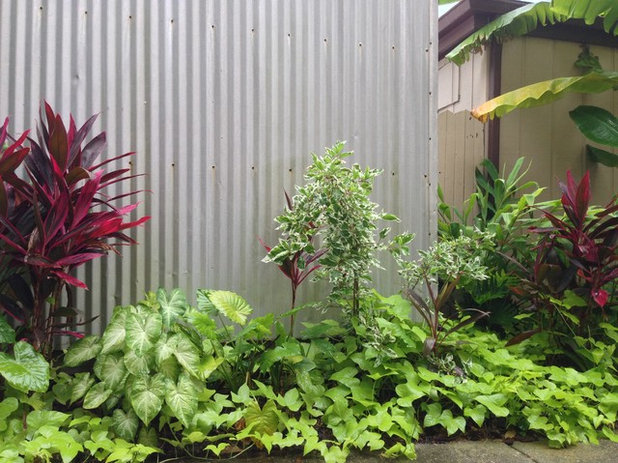
The corrugated tin shed was ugly, plain and simple. The tin was peeling away at the base; stray cats had made it their home; and it jutted out like a sore thumb. But I thought it would be cool to work with its industrial look and add some bold neon-colored plants that would turn the utilitarian shed into an attractive architectural element. Because I planted layers of foliage with different heights in a narrow space, the area feels larger and more dynamic.
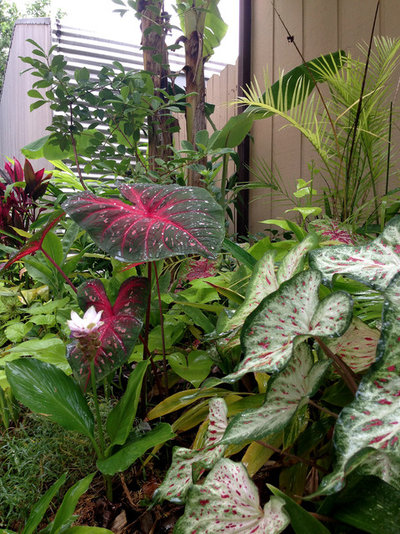
I'm often applauded by the other apartment complex residents for my supposed green thumb, but while I'm grateful for their kind words, the truth of the matter is that I rarely do anything to the plants at all, apart from occasionally pruning wayward stems.
Since I didn't plan to live at the apartment complex forever, I chose plants that would require little maintenance and could survive on their own. Tropical bulbs such as
Caladiums (
Caladium 'Red Flash', zones 9 to 11),
blood lily (
Haemanthus multiflorus, zones 8 to 11) and
Siam tulip (
Curcuma alismatifolia, zones 8 to 11) go dormant in winter and survive through our mild winters.
When they die back in fall, they're temporarily replaced with winter annuals and vegetables to keep the show going. Sweet peas ramble over the dormant leaves as a pleasant disguise.
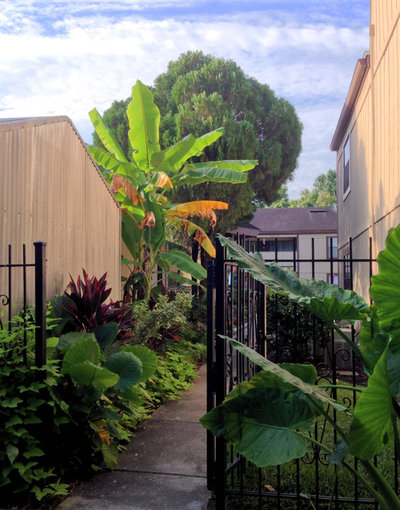 The Pitfalls (and Joys) of Gardening for the Public
The Pitfalls (and Joys) of Gardening for the PublicI was met with skepticism for trusting residents and their kids not to steal or trample over the plants, but apart from a few bromeliads that went missing during the first couple of months, neighbors have gone out of their way to protect the garden.
When a team of landscapers (the mow and blow crew) took a weed whacker to the plants and sprayed them with herbicide, I could count on my neighbors to set them straight. Apart from those mishaps, the garden has been a huge success. Every week a different neighbor goes out of his or her way to thank me for my work or ask me about a new flower.
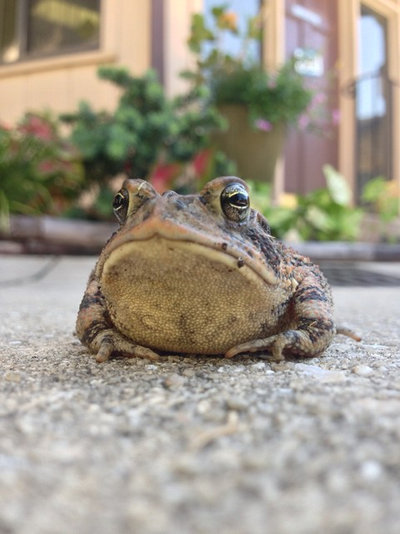
Oh, and the gardens attract lots of nature, including this cranky toad. Occasionally I'll find someone delicately stepping over the plantings to get a closer look at a flower, tree frog or garter snake, and with those tiny displays of wonder and curiosity, I know I've accomplished my goal.
You can't change the world by planting a garden, but you can use it to help make people just a little bit happier. And happy people make the world a better place; wouldn't you agree?
More: How to Give a Garden Soul





